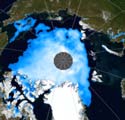In this guest post Neven Acropolis, the man behind the excellent Arctic Sea Ice blog, looks at the reasons why we need to pay attention to the rapid loss of sea ice in the Arctic Ocean.
Arctic sea ice became a recurrent feature on planet Earth around 47 million years ago. Since the start of the current ice age, about 2.5 million years ago, the Arctic Ocean has been completely covered with sea ice. Only during interglacials, like the one we are in now, does some of the sea ice melt during summer, when the top of the planet is oriented a bit more towards the Sun and receives large amounts of sunlight for several summer months. Even then, when winter starts, the ice-free portion of the Arctic Ocean freezes over again with a new layer of sea ice.
Since the dawn of human civilisation, 5000 to 8000 years ago, this annual ebb and flow of melting and freezing Arctic sea ice has been more or less consistent. There were periods when more ice melted during summer, and periods when less melted. However, a radical shift has occurred in recent times.

Ever since satellites allowed a detailed view of the Arctic and its ice, a pronounced decrease in summer sea ice cover has been observed (with this year setting a new record low). When the IPCC released its Fourth Assessment Report in 2007, it was generally thought that the Arctic could become ice-free somewhere near the end of this century. But changes in the Arctic have progressed at such speed that most experts now think 2030 might see an ice-free Arctic for the first time. Some say it could even happen this decade.
 What makes this event significant, is the role Arctic sea ice plays as a reflector of solar energy. Ice is white and therefore reflects a large part of incoming sunlight back out to space. But where there is no ice, dark ocean water absorbs most of the sunlight and thus heats up. The less ice there is, the more the water heats up, melting more ice. This feedback has all kinds of consequences for the Arctic region.
What makes this event significant, is the role Arctic sea ice plays as a reflector of solar energy. Ice is white and therefore reflects a large part of incoming sunlight back out to space. But where there is no ice, dark ocean water absorbs most of the sunlight and thus heats up. The less ice there is, the more the water heats up, melting more ice. This feedback has all kinds of consequences for the Arctic region.
Continue reading “Why Arctic sea ice shouldn’t leave anyone cold”
Like this:
Like Loading...

 The carefully cultivated cocoon of ignorance over at New Zealand’s own tiny corner of the climate crank echo chamber has been glinting in the harsh light of reality in recent weeks, as a number of climate realists (that is, people who have a realistic appreciation of what climate science is all about, not cranks attempting to purloin that term) have taken to bringing uncomfortable facts to the commentary under
The carefully cultivated cocoon of ignorance over at New Zealand’s own tiny corner of the climate crank echo chamber has been glinting in the harsh light of reality in recent weeks, as a number of climate realists (that is, people who have a realistic appreciation of what climate science is all about, not cranks attempting to purloin that term) have taken to bringing uncomfortable facts to the commentary under 
 What makes this event significant, is the role Arctic sea ice plays as a reflector of solar energy. Ice is white and therefore reflects a large part of incoming sunlight back out to space. But where there is no ice, dark ocean water absorbs most of the sunlight and thus heats up. The less ice there is, the more the water heats up, melting more ice. This
What makes this event significant, is the role Arctic sea ice plays as a reflector of solar energy. Ice is white and therefore reflects a large part of incoming sunlight back out to space. But where there is no ice, dark ocean water absorbs most of the sunlight and thus heats up. The less ice there is, the more the water heats up, melting more ice. This 
 Early results from the European Space Agency’s Cryosat-2 satellite, launched in 2010, suggest that the Arctic sea ice volume in summer is currently being lost at the rate of 900 cubic kilometres per year, Robin McKie
Early results from the European Space Agency’s Cryosat-2 satellite, launched in 2010, suggest that the Arctic sea ice volume in summer is currently being lost at the rate of 900 cubic kilometres per year, Robin McKie